Global high-mix volume high-speed Shenzhen PCBA manufacturer

Ru
9:00 -18:00, Mon. - Fri. (GMT+8)
9:00 -12:00, Sat. (GMT+8)
(Except Chinese public holidays)





Global high-mix volume high-speed Shenzhen PCBA manufacturer

Ru
9:00 -18:00, Mon. - Fri. (GMT+8)
9:00 -12:00, Sat. (GMT+8)
(Except Chinese public holidays)





HomePage > Blog > Knowledge Base > Analog vs. Digital Antenna: What is the Difference?
Many homeowners feel confused about TV antennas. People are constantly asking me for analog vs. digital antenna and they should upgrade. A common misunderstanding must be cleaned - there is nothing called a "digital antenna". Each antenna acts as an analog device that captures radio frequency (RF) signals from the air.

The purpose of the design is to distinguish these antennas and how they achieve specific broadcast signals. TV stations were only used to broadcast analog signals. Now they send digital signals, which have completely changed the reception for the TV content.
The term "analog antenna" refers to the older models manufactured for VHF (very high frequency) signals that rule on analog transmission. A "digital antenna" UHF (Ultra High Frequency) works best with signals, where most digital TV channels are broadcast today.
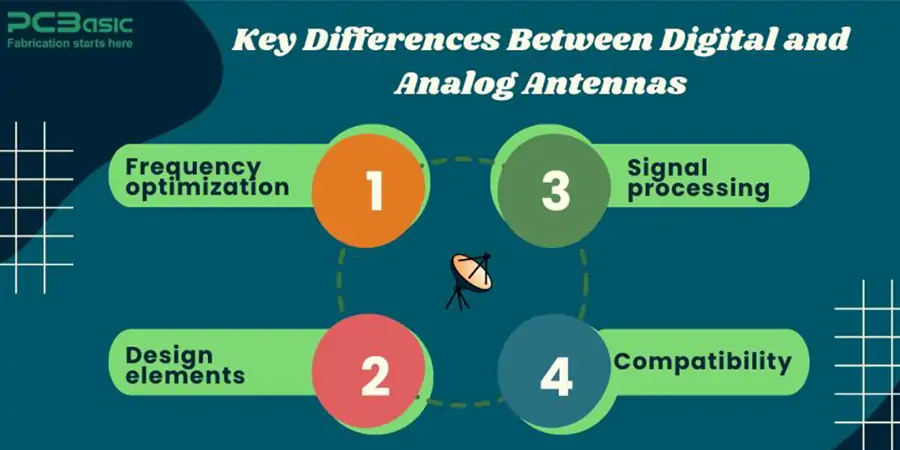
1. Frequency optimization
Digital antennas is better suited to capture the UHF signal (channel 14-51), while analog antenna was designed to take VHF signal (channel 2-13).
2. Design elements
Modern "digital" antennas use special items such as a loop or bow-tie configuration to improve the UHF reception.
3. Signal processing
Modern antennas have built-in filters and amplifiers that increase digital signals and reduce interference.
4. Compatibility
Any antenna is able to achieve electromagnetic waves, but their efficiency varies according to their configuration and type of signal.
The actual distinction is not between analog and digital antennas, but between the capacity of antennas to pick up various broadcast signals. Your converter box or TV actually does process the signals - the antenna merely receives them.
The following sections will elaborate on both antennas in depth. We will highlight their specific characteristics and assist you in determining whether an upgrade is worth it for you.

Analog antennas are the core technology of signal reception history. The devices were the standard before the digital broadcasting age. The engineers designed them to decode analog signals that dominated the airwaves for decades. Analog antennas work as metal conductors that interact with electromagnetic waves and convert them into electrical signals for televisions or radios.
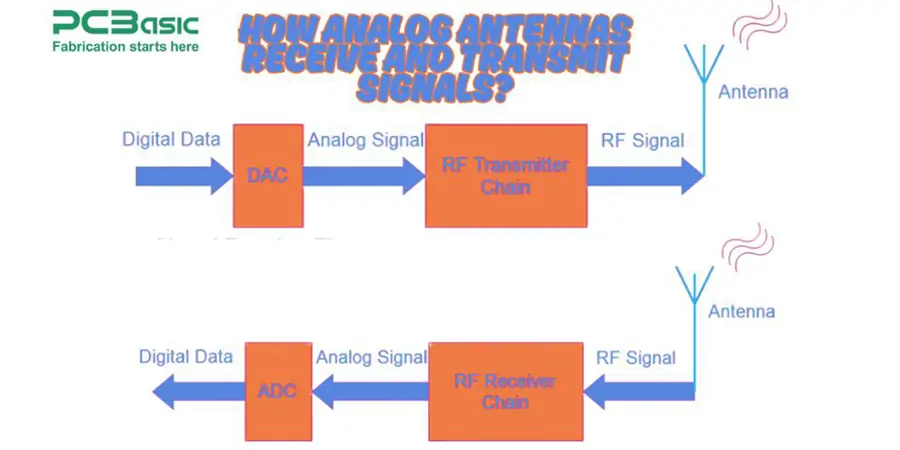
The fundamental concept of analog antennas is the transformation of electromagnetic waves into electric current. The antenna transforms alternating electric current into radio waves that are propagated through space in broadcasting. The antenna receives these waves and transforms them into an electric current that your device uses in reception.
Analog antennas are distinguished from digital antennas in that they operate on constant signals transmitted in real time. That they are constant means weak signals will get to receivers also, although quality still degrades and will more often than not create the familiar "snowy" or blurred image. Quality of signal deteriorates with farther distance from the source and is more prone to interference.
The antennas form a frequency-sensitive resonant circuit. They usually function as monopoles, a single linear conductor, or dipoles, two linear conductors, that receive electromagnetic waves that propagate through the air.
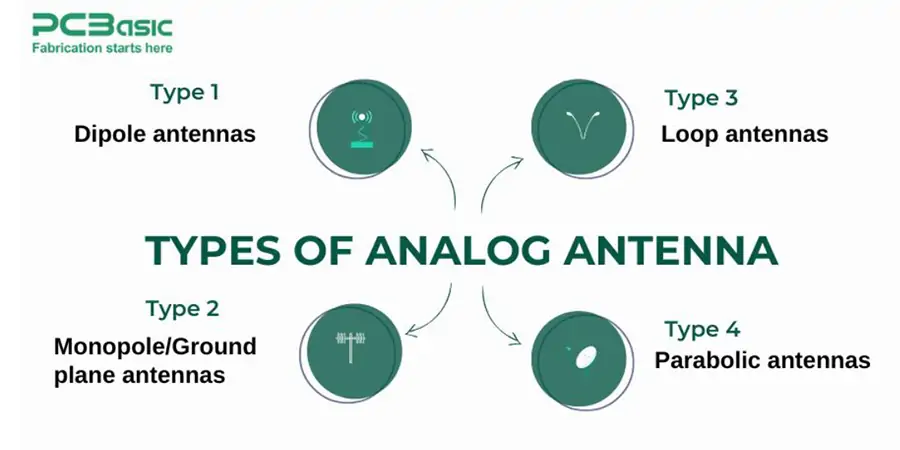
Analog antennas come in several types, each with unique characteristics:
1. Dipole antennas
The simplest configuration, which includes two straight wires of total length one-half wavelength (λ/2), creates a horizontally polarized wave.
2. Monopole/Ground plane antennas
A quarter-wave vertical radiator driven against the ground or a metal plate radiates an omnidirectional pattern.
3. Loop antennas
Treat the magnetic field as being more important than the electric field, making them relatively less sensitive to electrical noise.
4. Parabolic antennas
Use a parabolic dish as a reflector to focus signals, thus providing improved directional gain.
Analog antennas are still relevant in conventional radio broadcasting, air traffic control, and specialty uses, though digital transmission standards have been a recent trend.

Digital antennas remain one of the most misunderstood technologies in the new TV age. Everyone assumes "digital" and "analog" antennas are physically distinct. The truth is, both devices receive electromagnetic signals. Modern digital antennas simply do a better job at receiving digital TV broadcasts.
Digital antennas receive electromagnetic signals transmitted by nearby broadcast stations through the air (OTA). Radio waves from digital TV signals induce metal components of the antenna to generate an electrical current at particular frequencies. The current travels along a coaxial cable to your television and is processed into something viewable.
OTA broadcasts provide uncompressed, crystal-clear 1080i, superior to cable or satellite quality. Digital signals also carry next-generation compression and error correction technologies that ensure reception is more stable than analog signals.
Modern digital antennas bring several key benefits:

1. Superior picture quality
They deliver uncompressed high-definition material with sharper images and better audio.
2. Access to subchannels
Digital broadcasting allows for the inclusion of different subchannels (e.g., 8.1, 8.2) within the station's frequency license.
3. Cost-effectiveness
You only need to pay once for the antenna without any monthly fee for OTA broadcasts.
4. Range capabilities
Digital antennas can receive signals from 35 to 150 miles away, depending on the model.
5. Signal stability
Digital technology makes reception more consistent under different conditions.
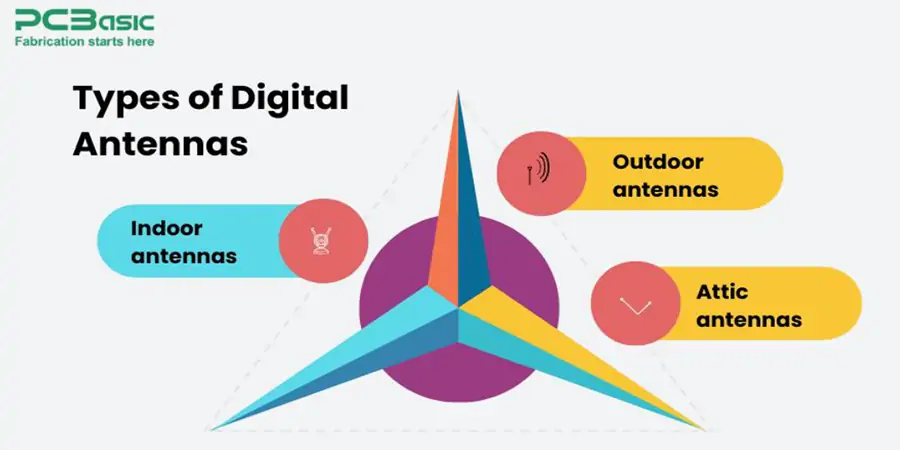
Digital antennas come in several forms that suit different environments:
Indoor antennas
Small designs are most effective in urban areas within a 30-mile radius of transmission towers. Small designs include flat panels, table designs, and amplified designs.
Outdoor antennas
Roof-top units have the greatest range (40-60+ miles) and are best suited for suburban and rural locations.
Attic antennas
These units reside within buildings, which are protected from the elements, and serve to connect indoor and outdoor performance.
Your proximity to broadcast towers will assist you in deciding which is best for you.
Recognizing the fundamental differences between digital and analog antennas allows people to make informed decisions regarding their television reception systems. These differences extend beyond the antennas themselves and influence the processing and delivery of signals.
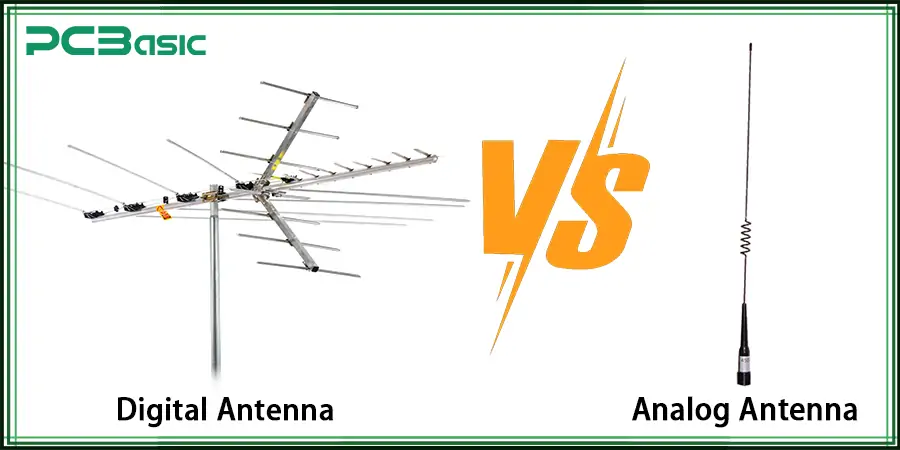
The difference in quality between analog and digital signals is evident. Analog signals keep getting worse, creating "snowy" pictures and audio replete with static as the signal degrades. Digital signals, on the other hand, work differently. They are flawless in quality until they reach a breaking point, known as the "digital cliff effect." After crossing that point, the picture does not degrade step by step; rather, it can freeze, pixelate, or simply vanish.
Picture quality is also fundamentally different. Digital broadcasts provide you with higher resolution (720p, 1080i, or even 4K). Analog signals topped out at 480i resolution. Digital signals also aren't scrambled even with the presence of minor interference that would otherwise scramble analog reception.
Digital signals apply sophisticated compression technology that allows more information to be sent over the same bandwidth. A single digital channel can convey multiple subchannels (e.g., 4.1, 4.2, 4.3) with different programs.
Integrated error correction of digital broadcasting is a big advantage. Digital receivers can reconstruct lost data when minor signal interruptions occur. That is uninterrupted viewing for you. Analog systems lack this, and even minor interference distorts the picture immediately.
Analog signals can be handled by older televisions with additional hardware. Dedicated decoding devices are needed for digital signals. Contemporary TVs have integrated digital tuners (ATSC tuners). Analog older televisions need external converter boxes to watch digital broadcasts.
This decoding disparity is why individuals believe they require a "digital antenna." They are referring to the receiving equipment and not the antenna.
The television broadcasting industry has largely switched to digital transmission standards. Full-power analog TV broadcasting stopped in 2009 in America. Low-power broadcasting persisted until 2021. This switch altered television viewing as digital broadcasting is more economical in the usage of the UHF spectrum compared to analog.
Antenna technology can now receive these frequencies better. Current "digital antennas" today have separate components designed for UHF signals, where the majority of digital channels live.
|
Characteristic |
Analog Antennas |
Digital Antennas |
|
Main Frequency Range |
VHF (channels 2-13) |
UHF (channels 14-51) |
|
Signal Degradation |
Gradual degradation with "snowy" picture |
Abrupt "digital cliff effect" - picture freezes or disappears |
|
Resolution |
Limited to 480i |
Supports up to 1080i and higher |
|
Signal Processing |
Simple signal reception |
Features built-in amplifiers and filters for digital signals |
|
Design Elements |
Traditional dipole or monopole designs |
Specialized elements like loop or bow-tie designs |
|
Reception Range |
Not specified |
35 to 150 miles, depending on the model |
|
Channel Capability |
Single channel per frequency |
Multiple subchannels are possible (e.g., 8.1, 8.2) |
|
Interference Handling |
More vulnerable to interference |
Better stability and error correction |
|
Common Types |
- Dipole antennas- Monopole/Ground plane- Loop antennas- Parabolic antennas |
- Indoor antennas- Outdoor antennas- Attic antennas |
|
Picture Quality |
Affected by minor interference |
Uncompressed, crystal-clear reception until the signal loss |

The choice to upgrade from an older antenna to a newer "digital" model comes down to your specific needs. All antennas pick up radio frequency signals - the main difference lies in how they handle different broadcast frequencies.
Do you need to buy a new antenna? Here's what matters:
Your current reception quality
Your old antenna might work just fine if it gets all the channels you want clearly. The old saying "if it isn't broken, don't fix it" fits perfectly here.
Your television
New TVs include digital tuners (ATSC tuners) built in, which decode digital signals. Old analog TVs require a converter box, regardless of the antenna you have.
Your location
How well you receive signals depends heavily on your distance from broadcast towers and nearby obstacles. Sometimes the antenna's position matters more than its type.
Broadcast frequencies in your area
Digital channels mainly use the UHF frequency, and older antennas used to be made for VHF signals. An antenna of a newer generation will be useful if the local channels only transmit UHF.
Most individuals will be able to improve their reception simply by moving their current antenna. Another inexpensive solution. However, if one continues to have issues like pixelation, loss of signal, or missing channels, one may want to consider looking at a newer model with such capabilities as multi-directional reception or internal amplification.
A new antenna makes sense when:
1. Your current antenna struggles with UHF signals
2. You live farther from broadcast towers now
3. You want to watch more channels
4. Your old antenna shows physical damage or wear
People utilize antennas that are decades old but still get great digital reception. The trick is not whether or not an antenna is "digital" marked; instead, one needs to learn how to capture the exact frequencies that your local broadcasters are transmitting. It is best to experiment with your current setup extensively before spending money on new equipment.
The difference between digital and analog antennas are much easier than many people think. Both devices mainly perform the same: they receive electromagnetic waves from the atmosphere, but with different approaches to signal handling. The difference is in design, which is configured to achieve specific broadcast frequencies and signal types.
My investigation has some unexpected revelations. Modern "digital" antennas work fairly well with UHF signals, with most TV channels broadcast today. These types of antennas provide access to many subchannels and improve the quality of the pictures. But do not yet throw your current analog antenna, as it will handle digital signals quite well when placed in the right place.
The option between analog and digital antennas boils down to where you live and what you want to see. Instead of getting stuck in the label, think of things like signal strength, available channels, and how well you can get them. Good TV reception depends more on picking the right antenna and putting it in the right spot than on what the marketing says.
People often ask questions about antennas when they want to improve their TV reception. Here are the answers to common questions about analog and digital antennas.
Analog signals are mostly gone, but if needed, use rabbit ears for VHF and loop antennas for UHF. A modern antenna that supports both VHF/UHF works for analog, too.
Yes, digital antennas offer a clearer picture, better sound, and more channels. They’re built for modern broadcasts and work well even in bad weather.
Place indoor antennas near a window. Mount outdoor ones high up, like on a roof, and connect the coax cable to your TV’s “Antenna In.” Ground it for safety, scan for channels, and call a pro if it’s too high to reach.
Yes! Old analog antennas can still catch digital signals. Just add a digital converter box for older TVs, point the antenna toward broadcast towers, and scan for channels now and then.

Assembly Enquiry
Instant Quote